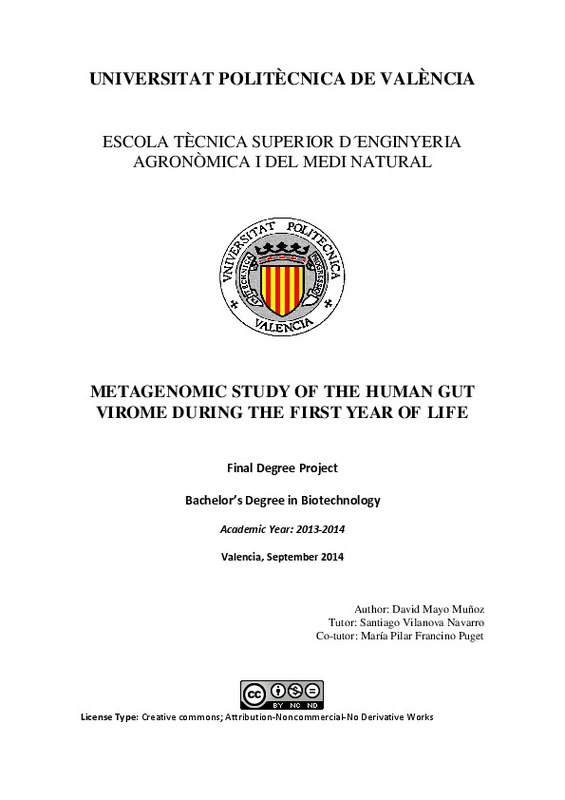JavaScript is disabled for your browser. Some features of this site may not work without it.
Buscar en RiuNet
Listar
Mi cuenta
Estadísticas
Ayuda RiuNet
Admin. UPV
Metagenomic study of the human gut virome during the first year of life
Mostrar el registro sencillo del ítem
Ficheros en el ítem
| dc.contributor.advisor | Francino Puget, María Pilar
|
es_ES |
| dc.contributor.advisor | Vilanova Navarro, Santiago
|
es_ES |
| dc.contributor.author | Mayo Muñoz, David
|
es_ES |
| dc.date.accessioned | 2015-01-16T19:07:35Z | |
| dc.date.available | 2015-01-16T19:07:35Z | |
| dc.date.created | 2014-09-01 | |
| dc.date.issued | 2015-01-16T19:07:35Z | |
| dc.identifier.uri | http://hdl.handle.net/10251/46160 | |
| dc.description.abstract | [ES] A pesar de la importante función de la microbiota en el tracto gastrointestinal y su impacto en la salud durante toda la vida, el proceso de sucesión a través del cual se desarrolla esta comunidad microbiana durante la infancia es aún poco conocido. Especialmente, se sabe poco sobre como la cantidad y tipo de virus, es decir, el viroma, varía a través de este periodo y sobre la función que este conjunto de virus puede desarrollar en el ensamblaje de la microbiota del tracto gastrointestinal. En este estudio se analizaron los patrones de cambio taxonómico en la comunidad viral del tracto gastrointestinal en una cohorte de niños sanos durante el primer año de vida. Para ello, se utilizaron muestras fecales que fueron recogidas a diferentes tiempos para los niños y sus madres. El ADN viral fue aislado, amplificado aleatoriamente utilizando la polimerasa phi29 y secuenciado por pirosecuenciación 454. A continuación, las secuencias virales obtenidas fueron taxonómicamente asignadas por medio de análisis bioinformáticos para establecer la composición del viroma presente en cada muestra. Finalmente, se realizaron análisis estadísticos para evaluar el proceso de la dinámica viral a través del tiempo. A través del análisis tanto de la riqueza y diversidad taxonómicas como del clustering de muestras en base a la composición y la abundancia viral, se ha observado que la dinámica viral en el intestino es distinta en cada individuo y no se han podido identificar patrones claros. Sin embargo, se han observado tendencias generales en el desarrollo del viroma, como el decrecimiento de la riqueza y la diversidad taxonómicas durante el primer año de vida, contrariamente al comportamiento de la microbiota bacteriana, y un cambio direccional a través del tiempo hacia la composición taxonómica del viroma materno. | es_ES |
| dc.description.abstract | [EN] Despite the important role of the microbiota in the human gastrointestinal tract (GIT) and its impact on life-long health, the successional process through which this microbial community develops during infancy is still poorly understood. Specially, little is known about how the amount and type of viruses present in the GIT, i. e. the virome, varies throughout this period and about the role this collection of viruses may play in the assembly of the GIT microbiota. In this study, the patterns of taxonomic change of the GIT viral community were analyzed in a birth cohort of healthy infants during the first year of life. Fecal samples were collected at different timepoints for the infants and their mothers. Viral DNA was isolated, randomly amplified using phi29 polymerase and sequenced through high-throughput 454 pyrosequencing. Then, the obtained viral sequences were taxonomically assigned through bioinformatic analyses to establish the composition of the virome present in each sample. Finally, statistical analyses were performed in order to assess the process of viral dynamics through time. Through the analysis of taxonomic richness and diversity, as well as clustering based on viral composition and abundance, it has been observed that individual instances of viral dynamics in the gut are distinct, and clear patterns have not been identified. However, general trends have been observed in virome development, such as the decrease of viral taxonomic richness and diversity during the first year of life, contrary to the behaviour of the bacterial microbiota, and a directionality of change through time towards the taxonomic composition of the maternal virome. | es_ES |
| dc.format.extent | 37 | es_ES |
| dc.language | Inglés | es_ES |
| dc.publisher | Universitat Politècnica de València | es_ES |
| dc.rights | Reconocimiento - No comercial - Sin obra derivada (by-nc-nd) | es_ES |
| dc.subject | diversidad taxonómica | es_ES |
| dc.subject | riqueza taxonómica | es_ES |
| dc.subject | microbiota del tracto gastrointestinal | es_ES |
| dc.subject | Viroma | es_ES |
| dc.subject | taxonomic diversity | es_ES |
| dc.subject | taxonomic richness | es_ES |
| dc.subject | GIT microbiota | es_ES |
| dc.subject | Virome | es_ES |
| dc.subject.classification | GENETICA | es_ES |
| dc.subject.other | Grado en Biotecnología-Grau en Biotecnologia | es_ES |
| dc.title | Metagenomic study of the human gut virome during the first year of life | es_ES |
| dc.type | Proyecto/Trabajo fin de carrera/grado | es_ES |
| dc.rights.accessRights | Abierto | es_ES |
| dc.contributor.affiliation | Universitat Politècnica de València. Escuela Técnica Superior del Medio Rural y Enología - Escola Tècnica Superior del Medi Rural i Enologia | es_ES |
| dc.description.bibliographicCitation | Mayo Muñoz, D. (2014). Metagenomic study of the human gut virome during the first year of life. http://hdl.handle.net/10251/46160. | es_ES |
| dc.description.accrualMethod | Archivo delegado | es_ES |
Este ítem aparece en la(s) siguiente(s) colección(ones)
-
ETSIAMN - Trabajos académicos [3541]
Escuela Técnica Superior de Ingeniería Agronómica y del Medio Natural






